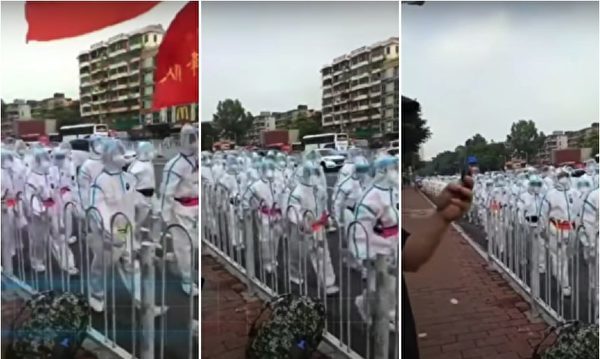[The Epoch Times, November 24, 2022](Comprehensive report by Epoch Times reporter Xia Song) Recently, a Hubei woman hanged herself to death during quarantine in a shelter in Nansha, Guangzhou. Before she committed suicide, she said that she didn’t want to go back to her hometown during the Chinese New Year, for fear of contracting the virus and going back to her hometown to be gossiped. The husband cried bitterly, “It’s not too serious, why can’t you think about it?”
When the world has opened up to coexist with the virus, many Chinese are still living in the “talk” of the CCP’s zeroing out. The highly contagious and low-toxic Amicron makes them fearful.
Caixin Network Report on Woman’s Suicide in Guangzhou’s Nansha Quarantine Site Taken Down
On November 16, a 32-year-old woman from Henglin Town, Tianmen City, Hubei Province was forced to be quarantined in a shelter at Nansha Stadium by the Nanzhou Sub-district Office and community in Guangzhou City because of a positive nucleic acid test. Two days later, she hanged herself in the bathroom of the isolation point, leaving behind two young left-behind children, a 9-year-old and a 5-year-old.
After five days of silence, the Lu media Caixin.com reported on the 23rd, and Sina.com reposted the article, but both were removed from the shelves.
Radio Free Asia said that after the incident, there were thousands of witnesses and insiders inside and outside the isolation point, and many local media had already received reports many times. Officials deliberately did not release her name. In Shangchong Village, Nanzhou Street, Guangzhou City, where she last lived, and in the grand narrative of the CCP’s official epidemic prevention, her name is still missing to this day.
According to Caixin.com, she tested positive for nucleic acid on the 14th and was sent to the isolation point at the Nansha Stadium in Guangzhou on the 16th. Her husband, who became a close contact, left the rented urban village one day earlier than her and was transferred to a hotel in Conghua District, northern Guangzhou. The two are separated from each other in the south and the north, and the distance between the two places is nearly 100 kilometers.
She was the first group of people to be stationed in the isolation point of Nansha Stadium. When she first arrived in the shelter, fellow villagers in the same village who were isolated with her heard her say, “I’m not used to it.”
The fellow said, “When I first came in, it was empty, only densely packed single beds, quilts, and pillows.” The beds in the isolation point were next to each other, the air was stuffy, and there was not much room for movement.
On the afternoon of the 17th, after she learned that her husband was also diagnosed with the infection, she became very depressed. The fellow told Caixin, “She said that she didn’t want to go back to her hometown after the Chinese New Year. She stayed in Guangzhou. She was afraid that if she contracted the virus, she would be gossiped by her family.”
On the morning of November 18, she hanged herself in the bathroom of Nansha Gymnasium. That night, her husband saw her for the last time, and while taking a video, he wept bitterly, “It’s not too serious, why can’t you think about it?”
Faced with doubts from the outside world, a reporter from Radio Free Asia called the Nanzhou Sub-district Party and Government Office. Officials from the agency said that they did not know of someone committing suicide, and there was no question of how to deal with the aftermath.
The Nanzhou Sub-district Office stated, “We made the unified arrangements based on the city’s disease control. For example, people who are quarantined or treated in a centralized manner do not just go to Nansha Fangcang. Where did you get (the news)? You can ask where. “
The Omicron virus did not kill people, the fear created by the CCP killed people
In the recent outbreak of the epidemic in China, the CCP still adheres to the zero-clearing policy. Professor Jin Dongyan, a virologist at the Faculty of Medicine of the University of Hong Kong, told DW that the fatality rate of Omicron is lower than that of seasonal flu, and the important thing is to prevent “fear killing”.
He said that the run on medical resources was not due to the virus, but a man-made disaster, which was caused by people’s understanding, not because the virus itself was so powerful that it could kill so many people.
Jin Dongyan said that people are afraid of being pulled into the shelter. Many people don’t need treatment, what they need is a psychologist, psychological treatment. If it is not handled well, it will become a virus that does not kill people, but fear kills people.
Zheng Xuguang, a scholar of Chinese descent, told the Epoch Times reporter recently that the epidemic prevention indicators should have shifted from the infection rate to the severe disease rate, mortality rate, and hospitalization rate. If the goal is shifted to these three items, the epidemic prevention will go smoothly. But political obstacles make it impossible to deny the slogan of dynamic zeroing.
Commentator Lei Ge told Voice of America when he was in the United States that the exodus of Foxconn workers was an absurd drama. When the Western world has opened up to coexist with the virus, the CCP still sticks to its defenses against the virus, shielding foreign scientific evidence, propagandizing and exaggerating the lethality of the Omicron virus, and creating a sense of fear among Chinese people about the virus. The culprit is the brainwashing of the virus.
Niels Graham, deputy director of the Center for Geoeconomics at the Atlantic Council, also told VOA that due to the long-term propaganda of the Chinese government, many Chinese people have a deep-rooted fear of the new crown virus (CCP virus).
Responsible Editor: Sun Yun#
